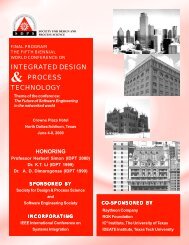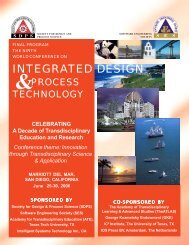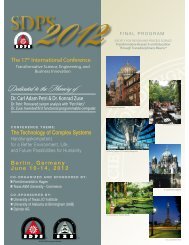IDPT(SDPS) 2008 Asia University
IDPT(SDPS) 2008 Asia University
IDPT(SDPS) 2008 Asia University
- No tags were found...
Create successful ePaper yourself
Turn your PDF publications into a flip-book with our unique Google optimized e-Paper software.
WORKSHOP-I On Integration:What Can We Learn from Chemistry and its EngineeringSponsored by GEMSAN-Istanbul-TurkeyTuesday June 3, <strong>2008</strong> 1:30 pm - 3:30 pmRoom: A101Transdiscipline: Integrating Science and Engineering PrinciplesWorkshop Organizers:Adem Unal, GEMSAN-Istanbul-Turkey; Murat M. Tanik, UAB,USA; Mehmet Aksit, <strong>University</strong> of Twente, The Netherlands;Tolga Tuncer, MD, Fellow, SJHMC-Barrow Neurological Institute,AZ, USA; I. Ozkarahan, Troy <strong>University</strong> Montgomery, AL, USA.WORKSHOP KEYNOTE SPEAKERTuesday, June 3, 1:30-2:00 pmRoom: A101Workshop Co-Chairs:Murat M. Tanik, UAB, USA, Mehmet Aksit, <strong>University</strong> ofTwente, The NetherlandsDescription:This year we are dedicating our “Intergation” workshop to <strong>SDPS</strong>-<strong>IDPT</strong> Opening address speaker Nobel Laureate Yuan T. Lee. Dr. Y.T. Lee’s work transformed our understanding of nature with hisdesign of molecular beam devices, so that we can view chemicalreactions. Chemistry studies the composition, structure, properties,and reactions of matter as atomic and molecular systems.Traditionally chemistry divided into areas such as analytical, inorganic,organic, and physical. Chemistry and its engineering haveplayed a fundamental role in the society affecting almost everythingwe do such as biology, agriculture, pharmaceuticals, forensics,and environment. In this context, we will discuss transdisciplinarynature of chemistry and it’s engineering. We wish to use this workshopas a vehicle to link researchers, educators and learners inways that will influence transdisciplinary education and researchat all levels. Previous “Integration” workshops were dedicated toErnst Mayr and Ilya Prigogine respectively.During June 2005 we have dedicated our first “integration” workshopto Eminent Harvard biologist Ernst Mayr. We had discussedtopics associated with the last book of Dr. Mayr “What makes biologyunique? in which he states “biology actually consists of tworather different fields, mechanistic (functional) biology and historicalbiology.” He recognizes the lack of “programmatic” aspect ininanimate world. However, considerations in information theory andcomputing provide a “programmatic” aspect to physics and chemistryand indirectly to Biology. In 2006, we dedicated our IntegrationWorkshop to the memory of Ilya Prigogine, Regental Professor ofPhysics and Chemical Engineering and director of the Ilya PrigogineCenter for Studies in Statistical Mechanics and Complex Systemsat The <strong>University</strong> of Texas at Austin who passed away in 2003. Hegreatly enhanced our understanding of irreversible processes insystems that are far from equilibrium, particularly in chemical andbiological systems. It has been known that irreversible behavior isactually observed in chemical, hydrodynamic, and biological systems,which remain one of the great mysteries of science. Ilya’sapproach was to study the “complexity” in general. The study of“complexity” intrigued Prigogine; and he and Dr. Kozmetsky hadmany long discussions on this matter. In 2007, we incorporatedour Integration Workshop with the traditional “TransdisciplinaryEducation Workshop” in which we discussed the ideas related to“transformative Research” as NSF defined it “research driven byideas that stand a reasonable chance of radically changing ourunderstanding of an important existing scientific concept or leadingto the creation of a new paradigm or field of science.Professor Oktay SinanogluYale <strong>University</strong>Endowed Chair, Molecular BiologyProfessor Oktay Sinanoglu has been nominated twice for NobelPrize. He is a Turkish scientist of theoretical chemistry and molecularbiology. At age 28, he became the youngest person in 20th centuryat Yale <strong>University</strong> to attain status as a full professor. Sinanogluwas born in 1935 in Bari, Italy where his father served as a consulgeneral. The family returned to Turkey at the start of World War II in1939. In 1953, he attended TED Yenisehir Lisesi high school inAnkara, and after graduating won a scholarship for education ofchemistry in the United States. In 1956, he graduated from the <strong>University</strong>of California, Berkeley in chemical engineering with the highestrank. In only eight months, he graduated from MIT in 1957 withthe highest degree. In two years, he finished his doctorate at UCBerkeley. In 1960, Sinanoglu started working as associate professorat Yale <strong>University</strong>. He theorized the "Many-Electron Theory ofAtoms and Molecules" in 1962 by solving a mathematical theoremthat had been unsolved for 50 years. The same year, he earned theAlfred P. Sloan prize. He was appointed full professor in 1961. Hegot his second life-long chair in Yale in Molecular Biology. ProfessorSinanoglu was the first to earn the Alexander von Humboldt’s SciencePrize in 1973. In 1975, he won the award of Japan’s InternationalOutstanding Scientist. In the 1980s, he theorized a newmethod from 180 theories concerning mathematics and physics,considered revolutionary, which enables chemists to predict the waysin which chemicals combine in the laboratory and to solve othercomplex problems in chemistry using simple pictures and periodictables. Also, he took his place in the Academy of Arts & Sciences. In1993, he moved to Turkey to teach at the Yildiz Teknik Universitesi,and officially retired at the age of 67. Yet his scientific researcheshave not ceased. He received several international and local awardsconcerning his scientific and social contributions and efforts. Hehas been to many places including <strong>Asia</strong> and Latin America. He triedto establish strong communications between Japan, India and Turkey.Because of his efforts, he was given the title "Special Emissary"of Japan-Turkey. He worked for better education, purified languagein Turkey most of his life and strived to form a conscious generation.








